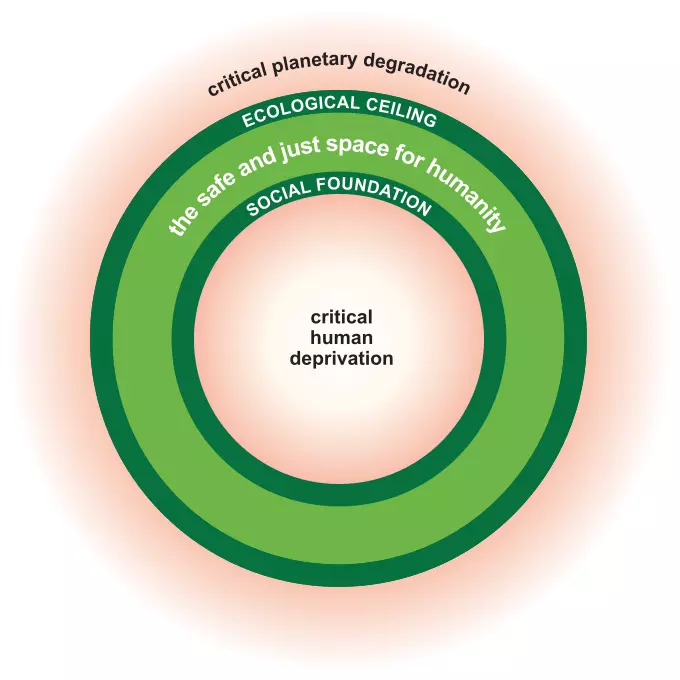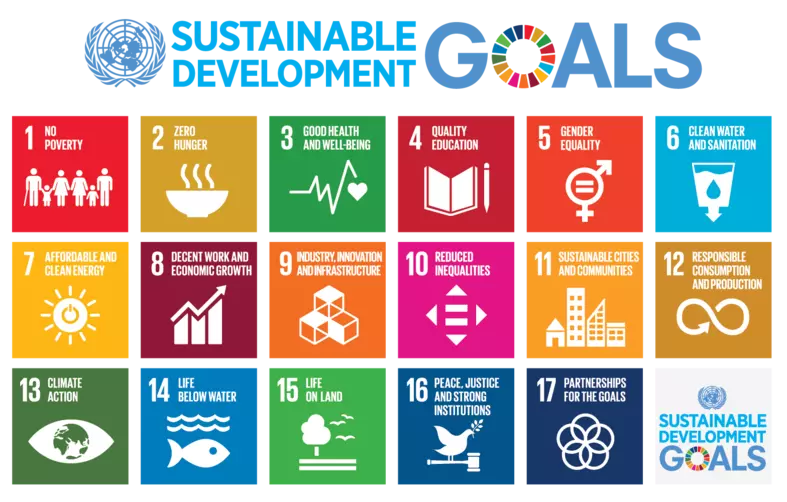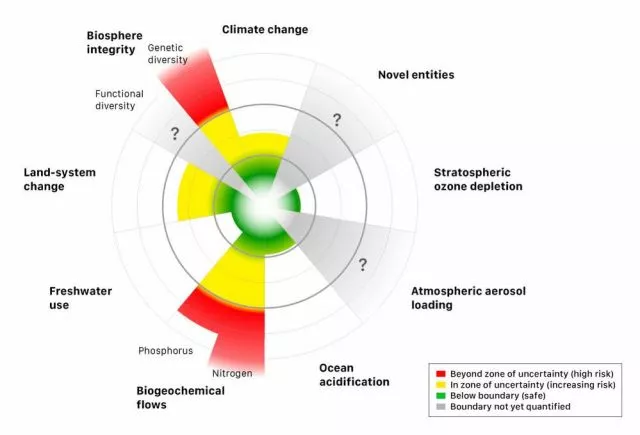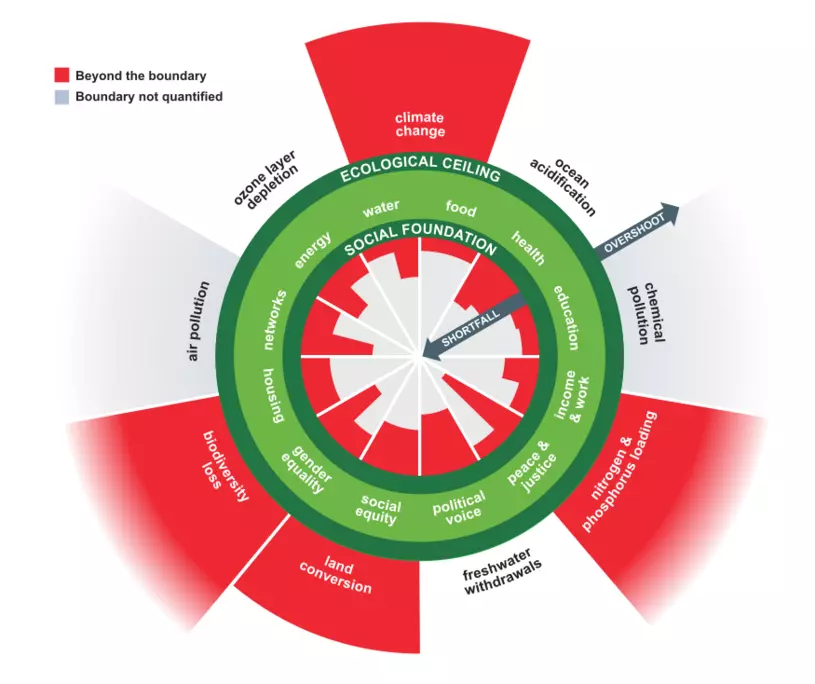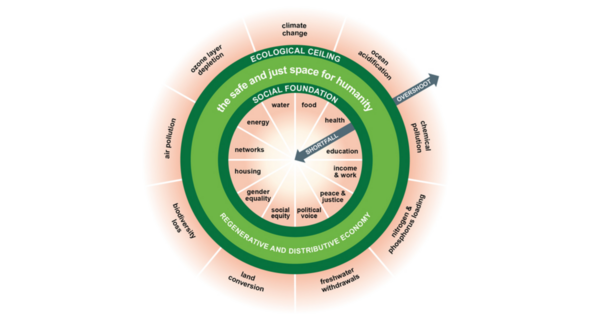
What is the Doughnut?
An introduction to the concept at the heart of Doughnut Economics

Version 1.0 (September 2020)
Overview
This tool is an introduction to the concept at the heart of Doughnut Economics. It's been designed as both a document that can be shared and a presentation that can be given in a classroom, a workshop or a meeting. Either download it as a pdf (below), open it within Google drive (links below) or scroll down to read on this page.
Links
Open as a document in Google Docs
Open as a presentation in Google Slides
What is the Doughnut?
Think of it as a compass for human prosperity in the 21st century, whose goal is to meet the needs of all people within the means of the planet.
It consists of two concentric rings:
- A social foundation – to ensure that no one is left falling short on life’s essentials.
- An ecological ceiling – to ensure that humanity does not collectively overshoot planetary boundaries.
Between these two boundaries lies a doughnut-shaped space that is both ecologically safe and socially just – a space in which humanity can thrive.
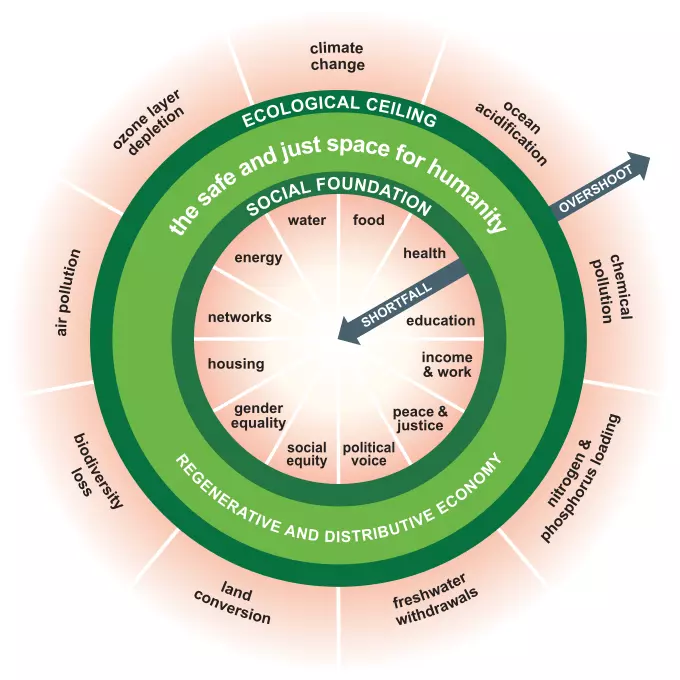
The essence of the Doughnut
1. The social foundation – below which lies critical human deprivation
2. The ecological ceiling – beyond which lies critical planetary degradation
These two boundaries are foundational in the sense that humanity should always seek to avoid critical human deprivation and critical planetary degradation. But how best to define their specific dimensions and measure their current status relative to desired outcomes will keep evolving over time.
The Doughnut’s dimensions
(as of 2017)
The Social Foundation
The 12 dimensions of the social foundation are derived from the social priorities agreed in the Sustainable Development Goals (UN, 2015).
The Ecological Ceiling
The 9 dimensions of the ecological ceiling are the nine planetary boundaries defined by Earth-system scientists (Steffen et al., 2015).
Quantifying the Doughnut
The image below reveals the current state of humanity and our planetary home: think of it as humanity’s ‘selfie’ in the early days of the 21st century.
Each dimension is measured, where possible, with 1 or 2 indicators, and the red wedges show the extent of shortfall and overshoot of the Doughnut’s social and planetary boundaries.
It shows us that millions of people still fall short on all 12 of the social dimensions, and that humanity has already overshot at least four planetary boundaries (air pollution and chemical pollution are currently unquantified).
To achieve the 21st century goal of meeting the needs of all within the means of the living planet means eliminating all of the red from the Doughnut diagram, and this must be done from both sides at the same time.
Find out more
- Explore the dimensions of the social foundation and ecological ceiling
- Explore the selection of these dimensions, including their limitations
- Read chapter one of Doughnut Economics: Seven Ways to Think Like a 21st-Century Economist
Share
Attachments
Share
-
Story

Doughnut economics on brillder
Our latest online learning module on brillder introduces students to doughnut economics
-
Story
.jpg)
Donut Brasil bursts into life!
Connecting diverse communities of practice around the idea and principles of the Donut
-
Story

Between D.E. and Gender Inclusion in Nigeria
Blending Doughnut Economics with Gender Inclusion as a solution for many challenges in Nigeria.
-
Story

Exploring sustainability in digital tech
Can Doughnut Economics be used as a holistic way of exploring the digital tech sector’s impact on global sustainability?
-
Story

Doughnut-PESTLE Hydrogen Model (DPHM)
Analysing the hydrogen economy by applying a Doughnut-PESTLE Hydrogen Model
-
Story

BORO Doughnut: DE in Middlesbrough
Bottom up practical steps taken to form a community action group and alliances to Downscale DE in a town
-
Story
.png)
Yerevan embraces “Doughnut mindset”
Reprioritizing priorities; Yerevan embraces “Doughnut mindset” on its way to sustainable development
-
Story

Renegade Neighbourhood Economists Wanted
Exploring Doughnut Economics in the round as peers.
-
Member


George Leith
Chilliwack, British Columbia, Canada
Have recently undergone a paradigm shift that has resulted in interest in Infinite Banking Concept, Doughnut Economics, Social and Climate Justice.
-
Member


Guilherme Rosa
Conselheiro Pena, Minas Gerais, Brasil
-
Member

ger pepels
-
Member


Kathy Gibbs
London, England, United Kingdom & Barbados
I am a chartered structural engineer who, in last several years, has held more multi-disciplinary design team leadership roles. I advocate for best practice in design and implementation throughout the built environment with a keen focus on sustainable (environmental, economic and social) development, and beyond resilient design. My project work has been diverse but has included a significant amount of healthcare related projects, and I have been supporting the promotion of healthy lifestyles in the built environment through planning and design. I am also a WELL AP. Disaster mitigation and disaster risk reduction are also key areas of interest. I am originally from the Caribbean region – an area particularly susceptible to natural hazards, such as hurricanes & earthquakes, & increasingly vulnerable because of the climate crisis, all hazards I have addressed in my work. My career has meant I have been based in Barbados, United Kingdom, Belgium, Turkey, Qatar, and The Netherlands.
-
Member


Shaktari Belew
Ashland, Oregon, United States of America
I am a life-long learner. From a early background in computer systems, which gave me a whole-systems lens through which to approach the rest of my life, I've been an educator, author, artist, Transition movement trainer/contributor (since 2008), Permaculture instructor/designer, group facilitator, complementary currency designer, researcher, parent, grandparent. I love seeing through multiple lenses and points-of-view. I guess you could say I am a Whole-Systems, Biomimicry, "DANCING ON MY LEARNING EDGES" explorer ... contributing, connecting, and loving, with joy.
-
Member

Luciana Maia
-
Member


Luis Osorio
Rionegro, Antioquia, Colombia
I describe myself as a continuous learner who has a passion for designing strategies to solve complex problems businesswise. However, I cannot stick only to the business side of things as our present has demonstrated that life and business are not as apart as I thought a few years ago. They are completely linked, and one relies on the other on a process that is constantly trying to find a clever (not always wise) way to help us, humans, perdure. For me, DEAL is HOPE, and it's giving us, humans, a new chance to make things right (and wise).
-
Member


Bob Thust
Brighton, England, United Kingdom
I co-founded a small networked business to provide practical support on governance across organisations, networks, communities and movements. Interested in how new and regenerative approaches to governance - issues of ownership, power, control, organising, (inter)dependence and decision-making in a variety of settings - can help support the foundations of a new economic system.
